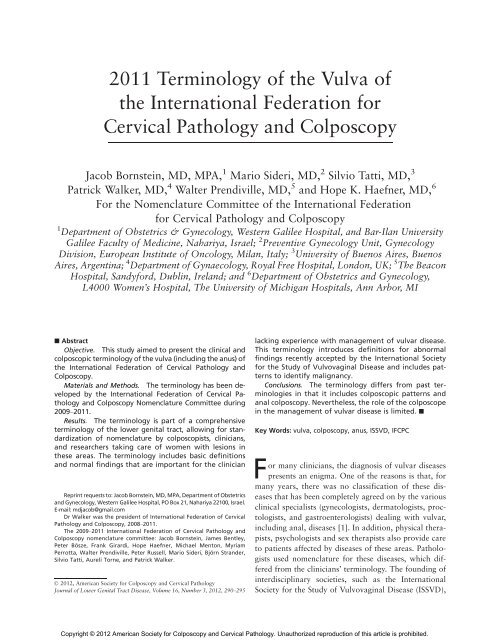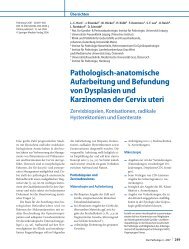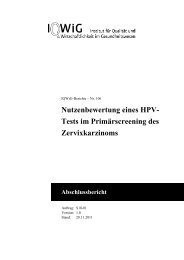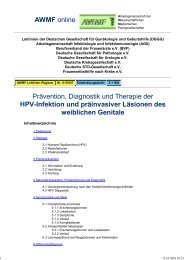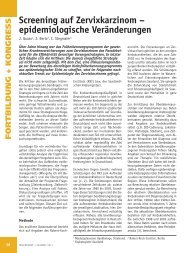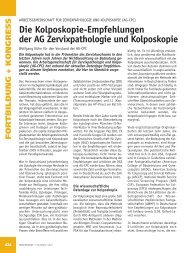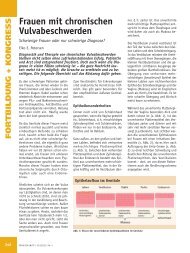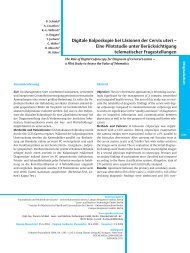2011 Terminology of the Vulva of the International Federation for ...
2011 Terminology of the Vulva of the International Federation for ...
2011 Terminology of the Vulva of the International Federation for ...
You also want an ePaper? Increase the reach of your titles
YUMPU automatically turns print PDFs into web optimized ePapers that Google loves.
<strong>2011</strong> <strong>Terminology</strong> <strong>of</strong> <strong>the</strong> <strong>Vulva</strong> <strong>of</strong><br />
<strong>the</strong> <strong>International</strong> <strong>Federation</strong> <strong>for</strong><br />
Cervical Pathology and Colposcopy<br />
Jacob Bornstein, MD, MPA, 1 Mario Sideri, MD, 2 Silvio Tatti, MD, 3<br />
Patrick Walker, MD, 4 Walter Prendiville, MD, 5 and Hope K. Haefner, MD, 6<br />
For <strong>the</strong> Nomenclature Committee <strong>of</strong> <strong>the</strong> <strong>International</strong> <strong>Federation</strong><br />
<strong>for</strong> Cervical Pathology and Colposcopy<br />
1 Department <strong>of</strong> Obstetrics & Gynecology, Western Galilee Hospital, and Bar-Ilan University<br />
Galilee Faculty <strong>of</strong> Medicine, Nahariya, Israel; 2 Preventive Gynecology Unit, Gynecology<br />
Division, European Institute <strong>of</strong> Oncology, Milan, Italy; 3 University <strong>of</strong> Buenos Aires, Buenos<br />
Aires, Argentina; 4 Department <strong>of</strong> Gynaecology, Royal Free Hospital, London, UK; 5 The Beacon<br />
Hospital, Sandy<strong>for</strong>d, Dublin, Ireland; and 6 Department <strong>of</strong> Obstetrics and Gynecology,<br />
L4000 Women’s Hospital, The University <strong>of</strong> Michigan Hospitals, Ann Arbor, MI<br />
h Abstract<br />
Objective. This study aimed to present <strong>the</strong> clinical and<br />
colposcopic terminology <strong>of</strong> <strong>the</strong> vulva (including <strong>the</strong> anus) <strong>of</strong><br />
<strong>the</strong> <strong>International</strong> <strong>Federation</strong> <strong>of</strong> Cervical Pathology and<br />
Colposcopy.<br />
Materials and Methods. The terminology has been developed<br />
by <strong>the</strong> <strong>International</strong> <strong>Federation</strong> <strong>of</strong> Cervical Pathology<br />
and Colposcopy Nomenclature Committee during<br />
2009Y<strong>2011</strong>.<br />
Results. The terminology is part <strong>of</strong> a comprehensive<br />
terminology <strong>of</strong> <strong>the</strong> lower genital tract, allowing <strong>for</strong> standardization<br />
<strong>of</strong> nomenclature by colposcopists, clinicians,<br />
and researchers taking care <strong>of</strong> women with lesions in<br />
<strong>the</strong>se areas. The terminology includes basic definitions<br />
and normal findings that are important <strong>for</strong> <strong>the</strong> clinician<br />
Reprint requests to: Jacob Bornstein, MD, MPA, Department <strong>of</strong> Obstetrics<br />
and Gynecology, Western Galilee Hospital, PO Box 21, Nahariya 22100, Israel.<br />
E-mail: mdjacob@gmail.com<br />
Dr Walker was <strong>the</strong> president <strong>of</strong> <strong>International</strong> <strong>Federation</strong> <strong>of</strong> Cervical<br />
Pathology and Colposcopy, 2008Y<strong>2011</strong>.<br />
The 2009Y<strong>2011</strong> <strong>International</strong> <strong>Federation</strong> <strong>of</strong> Cervical Pathology and<br />
Colposcopy nomenclature committee: Jacob Bornstein, James Bentley,<br />
Peter Bösze, Frank Girardi, Hope Haefner, Michael Menton, Myriam<br />
Perrotta, Walter Prendiville, Peter Russell, Mario Sideri, Björn Strander,<br />
Silvio Tatti, Aureli Torne, and Patrick Walker.<br />
Ó 2012, American Society <strong>for</strong> Colposcopy and Cervical Pathology<br />
Journal <strong>of</strong> Lower Genital Tract Disease, Volume 16, Number 3, 2012, 290Y295<br />
lacking experience with management <strong>of</strong> vulvar disease.<br />
This terminology introduces definitions <strong>for</strong> abnormal<br />
findings recently accepted by <strong>the</strong> <strong>International</strong> Society<br />
<strong>for</strong> <strong>the</strong> Study <strong>of</strong> Vulvovaginal Disease and includes patterns<br />
to identify malignancy.<br />
Conclusions. The terminology differs from past terminologies<br />
in that it includes colposcopic patterns and<br />
anal colposcopy. Never<strong>the</strong>less, <strong>the</strong> role <strong>of</strong> <strong>the</strong> colposcope<br />
in <strong>the</strong> management <strong>of</strong> vulvar disease is limited. h<br />
Key Words: vulva, colposcopy, anus, ISSVD, IFCPC<br />
For many clinicians, <strong>the</strong> diagnosis <strong>of</strong> vulvar diseases<br />
presents an enigma. One <strong>of</strong> <strong>the</strong> reasons is that, <strong>for</strong><br />
many years, <strong>the</strong>re was no classification <strong>of</strong> <strong>the</strong>se diseases<br />
that has been completely agreed on by <strong>the</strong> various<br />
clinical specialists (gynecologists, dermatologists, proctologists,<br />
and gastroenterologists) dealing with vulvar,<br />
including anal, diseases [1]. In addition, physical <strong>the</strong>rapists,<br />
psychologists and sex <strong>the</strong>rapists also provide care<br />
to patients affected by diseases <strong>of</strong> <strong>the</strong>se areas. Pathologists<br />
used nomenclature <strong>for</strong> <strong>the</strong>se diseases, which differed<br />
from <strong>the</strong> clinicians’ terminology. The founding <strong>of</strong><br />
interdisciplinary societies, such as <strong>the</strong> <strong>International</strong><br />
Society <strong>for</strong> <strong>the</strong> Study <strong>of</strong> Vulvovaginal Disease (ISSVD),<br />
Copyright © 2012 American Society <strong>for</strong> Colposcopy and Cervical Pathology. Unauthorized reproduction <strong>of</strong> this article is prohibited.
helped to establish an ongoing dialog between representatives<br />
<strong>of</strong> <strong>the</strong> different disciplines in an attempt to<br />
arrive at an accepted nomenclature <strong>for</strong> diagnostic and<br />
<strong>the</strong>rapeutic procedures [2, 3].<br />
However, <strong>the</strong>re are more players in <strong>the</strong> field. Many<br />
women affected by diseases <strong>of</strong> <strong>the</strong> vulva are referred<br />
<strong>for</strong> care to colposcopy clinics. Colposcopists take care<br />
<strong>of</strong> women with abnormal Pap smears. However, <strong>the</strong>y<br />
are also experienced in treating human papillomavirus<br />
(HPV)Yrelated diseases and intraepi<strong>the</strong>lial neoplasia<br />
<strong>of</strong> <strong>the</strong> whole lower genital tract. They use <strong>the</strong><br />
colposcopeVa magnifying optical tool; <strong>the</strong>y are capable<br />
<strong>of</strong> documenting <strong>the</strong> lesions and are experienced<br />
in administering treatment by carbon dioxide (CO2) laser,<br />
dia<strong>the</strong>rmy, and cryo<strong>the</strong>rapy, which are appropriate<br />
<strong>the</strong>rapies <strong>for</strong> lower genital tract lesions. In addition,<br />
<strong>the</strong>re has recently been an increase in <strong>the</strong> incidence<br />
<strong>of</strong> <strong>the</strong> diagnosis <strong>of</strong> anal intraepi<strong>the</strong>lial neoplasia (AIN),<br />
a precursor <strong>of</strong> anal carcinoma [4]. The high-resolution<br />
anoscopy examination, used to detect intraepi<strong>the</strong>lial<br />
and invasive anal neoplasia, is basically colposcopy <strong>of</strong><br />
<strong>the</strong> anus, and <strong>the</strong> treatment <strong>of</strong> this precancerous anal<br />
condition also involves use <strong>of</strong> <strong>the</strong> CO2 laser, cryo<strong>the</strong>rapy,<br />
and o<strong>the</strong>r destructive modalities found in colposcopy<br />
clinics.<br />
Never<strong>the</strong>less, although colposcopists use <strong>the</strong> terminology<br />
<strong>of</strong> <strong>the</strong> <strong>International</strong> <strong>Federation</strong> <strong>for</strong> Cervical Pathology<br />
and Colposcopy (IFCPC) to report <strong>the</strong> cervical<br />
findings, <strong>the</strong>re was no IFCPC terminology <strong>for</strong> vulvar<br />
patterns (including <strong>the</strong> anal region) recognized during<br />
<strong>the</strong> clinical or <strong>the</strong> colposcopic examination [5]. Clinicians<br />
who tried to use <strong>the</strong> terminology <strong>for</strong> vulvar disease<br />
<strong>of</strong> <strong>the</strong> ISSVD, <strong>the</strong> guardian organization <strong>of</strong> vulvar<br />
diseases, found that it did not include pattern recognition<br />
terminology but was ra<strong>the</strong>r a classification according<br />
to disease pathophysiology [2, 3]. Hence, <strong>the</strong><br />
reporting <strong>of</strong> vulvar findings has been inconsistent.<br />
There<strong>for</strong>e, <strong>the</strong> IFCPC nomenclature committee, which<br />
was established at <strong>the</strong> 2008 IFCPC world congress in<br />
Auckland, New Zealand, took on itself <strong>the</strong> task <strong>of</strong> creating<br />
a comprehensive, ‘‘total’’ lower genital tract colposcopic<br />
terminology, not only <strong>of</strong> cervical and vaginal colposcopy<br />
findings [6] but also <strong>of</strong> <strong>the</strong> vulvar, perineal, perianal, and<br />
anal regions. For that purpose, a subcommittee to establish<br />
<strong>the</strong> terminology <strong>of</strong> vulvar conditions was set up,<br />
headed by Dr Jacob Bornstein, MD, MPA, which included<br />
doctors Mario Sideri, MD, and Hope Haefner, MD.<br />
The IFCPC current and presidents-electVDrs Patrick<br />
Walker, Silvio Tatti, and Walter PrendivilleValso participated<br />
in <strong>the</strong> deliberations. The discussions were<br />
IFCPC <strong>Vulva</strong> <strong>Terminology</strong> & 291<br />
carried out through a dedicated Web site, by e-mail,<br />
and at meetings. The vulvar (including <strong>the</strong> anal) clinical<br />
and colposcopic terminology was accepted by <strong>the</strong><br />
general assembly <strong>of</strong> <strong>the</strong> IFCPC at <strong>the</strong> <strong>2011</strong> World congress<br />
in Rio de Janeiro, Brazil, and was finalized in<br />
March 2012. The aim <strong>of</strong> <strong>the</strong> IFCPC was to create <strong>the</strong><br />
terminology that would take into account <strong>the</strong> new<br />
ISSVD vulvar terminology, as well as add terminologies<br />
specific to o<strong>the</strong>r regions and be compatible with colposcopy.<br />
There<strong>for</strong>e, only after <strong>the</strong> new ISSVD terminology<br />
was ready [7] did <strong>the</strong> IFCPC vulvar nomenclature subcommittee<br />
complete its deliberations.<br />
As <strong>the</strong> representative body <strong>of</strong> <strong>the</strong> national societies <strong>of</strong><br />
colposcopy and cervical pathology, <strong>the</strong> IFCPC recommends<br />
that <strong>the</strong> <strong>2011</strong> vulvar (including <strong>the</strong> anus) terminology<br />
be implemented without delay <strong>for</strong> diagnosis,<br />
treatment, and research purposes.<br />
THE STRUCTURE OF THE VULVAR TERMINOLOGY<br />
The vulvar terminology table includes several sections<br />
(Table 1).<br />
The first part is <strong>the</strong> section on basic definitions. It<br />
describes <strong>the</strong> various structures <strong>of</strong> <strong>the</strong> vulva and anus<br />
and <strong>the</strong>ir compositionVskin or mucosa. Although some<br />
conditions affect both skin and mucosa, many diseases<br />
are unique to <strong>the</strong> skin alone or to <strong>the</strong> mucosa alone. We<br />
fur<strong>the</strong>r divided <strong>the</strong> skin into ‘‘hairy’’ (e.g., labia majora)<br />
and ‘‘nonhairy’’ (e.g., clitoris), as hairy skin harbors<br />
skin appendages, which may be involved in a variety <strong>of</strong><br />
diseases, affecting <strong>the</strong>ir treatment, such as vulvar intraepi<strong>the</strong>lial<br />
neoplasia (VIN). This should affect <strong>the</strong><br />
consideration <strong>for</strong> excision <strong>of</strong> VIN in hair-bearing areas<br />
versus CO2 laser vaporization in nonYhair-bearing areas,<br />
<strong>for</strong> example.<br />
The normal findings section includes micropapillomatosis,<br />
sebaceous glands (Fordyce spots), and vestibular<br />
redness. As stated earlier, <strong>the</strong> rationale is to educate<br />
<strong>the</strong> clinicians that <strong>the</strong>se are normal findings. Vestibular<br />
redness alone is not a sign <strong>of</strong> dermatitis or inflammation.<br />
The remainder <strong>of</strong> <strong>the</strong> terminology table is composed<br />
<strong>of</strong> pattern recognition nomenclature that can be arrived<br />
at with or without a colposcope or a magnifying lens.<br />
Once <strong>the</strong> pattern has been recognized, fur<strong>the</strong>r evaluation<br />
and differential diagnosis may be carried out.<br />
The abnormal findings <strong>of</strong> <strong>the</strong> vulvar terminology include<br />
various variables that characterize each lesion by<br />
its size, location, type, color, and secondary morphology,<br />
if present. Because <strong>the</strong>se terms are novel to colposcopists,<br />
Tables 2 and 3 detail <strong>the</strong>ir definitions.<br />
Copyright © 2012 American Society <strong>for</strong> Colposcopy and Cervical Pathology. Unauthorized reproduction <strong>of</strong> this article is prohibited.
292 & BORNSTEIN ET AL.<br />
Table 1. The <strong>2011</strong> IFCPC Clinical/Colposcopic <strong>Terminology</strong> <strong>of</strong> <strong>the</strong> <strong>Vulva</strong> (Including <strong>the</strong> Anus)<br />
Section Pattern<br />
Basic definitions Various structures:<br />
Urethra, Skene duct openings, clitoris, prepuce, frenulum, pubis, labia majora, labia minora, interlabial sulci,<br />
vestibule, vestibular duct openings, Bartholin duct openings, hymen, fourchette, perineum, anus, anal squamocolumnar<br />
junction (dentate line)<br />
Composition:<br />
Squamous epi<strong>the</strong>lium: hairy/nonhairy, mucosa<br />
Normal findings Micropapillomatosis, sebaceous glands (Fordyce spots), vestibular redness<br />
Abnormal findings General principles: size in centimeters, location<br />
Lesion type: Lesion color: Secondary morphology:<br />
& Macule & Skin-colored & Eczema<br />
& Patch & Red & Lichenification<br />
& Papule & White & Excoriation<br />
& Plaque & Dark & Purpura<br />
& Nodule & Scarring<br />
& Cyst & Ulcer<br />
& Vesicle & Erosion<br />
& Bulla & Fissure<br />
& Pustule & Wart<br />
Miscellaneous findings & Trauma<br />
& Mal<strong>for</strong>mation<br />
Suspicion <strong>of</strong> malignancy Gross neoplasm, ulceration, necrosis, bleeding, exophytic lesion, hyperkeratosis<br />
With or without white, gray, red, or brown discoloration<br />
Abnormal colposcopic/o<strong>the</strong>r<br />
magnification findings a<br />
a See explanatory text.<br />
The miscellaneous findings may describe various<br />
traumatic insults to <strong>the</strong> vulva such as hematoma, and<br />
<strong>the</strong> ‘‘suspicion <strong>of</strong> malignancy’’ contains patterns that<br />
should be biopsy examined so as to rule in or rule out<br />
vulvar cancer.<br />
The last section <strong>of</strong> <strong>the</strong> terminology describes <strong>the</strong><br />
abnormal colposcopic/o<strong>the</strong>r magnification findings and<br />
contains <strong>the</strong> colposcopic recognition <strong>of</strong> intraepi<strong>the</strong>lial<br />
neoplasia <strong>of</strong> <strong>the</strong> vulva, perineum, perianal, and anal areas.<br />
Colposcopy <strong>of</strong> <strong>the</strong> vulva after <strong>the</strong> application <strong>of</strong> acetic<br />
acid is discouraged as a routine examination; it can<br />
be useful where genital condylomata acuminata, intraepi<strong>the</strong>lial<br />
neoplasia, or early invasive cancer is suspected<br />
by inspection with <strong>the</strong> naked eye or with magnification,<br />
in both <strong>the</strong> vulvar and <strong>the</strong> anal areas. Colposcopic ex-<br />
Table 2. Definitions <strong>of</strong> Primary Lesion Types 7<br />
Acetowhite epi<strong>the</strong>lium, punctation, atypical vessels, surface irregularities<br />
Abnormal anal squamocolumnar junction (note location about <strong>the</strong> dentate line)<br />
Term Definition<br />
amination after <strong>the</strong> application <strong>of</strong> acetic acid (‘‘vulvoscopy,’’<br />
‘‘anoscopy’’) helps to delineate <strong>the</strong> lesion and<br />
choose <strong>the</strong> biopsy site. However, it should be underlined<br />
that <strong>the</strong> finding <strong>of</strong> acetowhitening alone is not specific<br />
on <strong>the</strong> vulva.<br />
DISCUSSION<br />
The decision <strong>of</strong> <strong>the</strong> IFCPC nomenclature committee<br />
to publish a terminology <strong>for</strong> <strong>the</strong> vulva (including <strong>the</strong><br />
anus) <strong>for</strong> colposcopists was debated by colposcopists<br />
and vulvar experts during <strong>the</strong> 3-year period <strong>of</strong> <strong>the</strong><br />
activity <strong>of</strong> <strong>the</strong> Nomenclature Committee <strong>for</strong> several<br />
reasons: colposcopists traditionally examine <strong>the</strong> cervix<br />
with a colposcope after staining it with 3% to 5%<br />
Macule Small (G1.5 cm) area <strong>of</strong> color change; no elevation and no substance on palpation<br />
Patch Large ( 91.5 cm) area <strong>of</strong> color change; no elevation and no substance on palpation<br />
Papule Small (G1.5 cm) elevated and palpable lesion<br />
Plaque Large ( 91.5 cm) elevated, palpable, and flat-topped lesion<br />
Nodule A large papule ( 91.5 cm); <strong>of</strong>ten hemispherical or poorly marginated; may be located on <strong>the</strong> surface, within, or below <strong>the</strong> skin;<br />
nodules may be cystic or solid<br />
Vesicle Small (G0.5 cm) fluid-filled blister; <strong>the</strong> fluid is clear (blister: a compartmentalized, fluid-filled elevation <strong>of</strong> <strong>the</strong> skin or mucosa)<br />
Bulla A large ( 90.5 cm) fluid-filled blister; <strong>the</strong> fluid is clear<br />
Pustule Pus-filled blister; <strong>the</strong> fluid is white or yellow<br />
Copyright © 2012 American Society <strong>for</strong> Colposcopy and Cervical Pathology. Unauthorized reproduction <strong>of</strong> this article is prohibited.
Table 3. Definitions <strong>of</strong> Secondary Morphology Presentation<br />
Term Definition<br />
acetic acid to detect intraepi<strong>the</strong>lial neoplasia. On <strong>the</strong><br />
cervix, colposcopy evaluates a small area, <strong>the</strong> trans<strong>for</strong>mation<br />
zone, under different circumstances. However,<br />
<strong>the</strong> vulva has an anatomic structure different from<br />
<strong>the</strong> cervix because it is composed <strong>of</strong> skin and mucosa<br />
[8]. The colposcope itself is not a necessary instrument<br />
<strong>for</strong> dealing with vulvar diseases because many experts<br />
who examine and treat vulvar disease are providers, <strong>of</strong><br />
whom many do not use colposcopes and do not apply<br />
acetic acid to stain <strong>the</strong> vulvar tissue. Some <strong>of</strong> <strong>the</strong>se<br />
providers were concerned that introducing a colposcopic<br />
terminology <strong>of</strong> vulvar disease might erroneously<br />
imply that vulvar disease should be taken care <strong>of</strong> only<br />
by colposcopists. To address this concern, <strong>the</strong> current<br />
terminology has been entitled, ‘‘<strong>2011</strong> IFCPC clinical/<br />
colposcopic terminology,’’ and it includes an explanation<br />
<strong>of</strong> <strong>the</strong> limited role <strong>of</strong> <strong>the</strong> colposcope in <strong>the</strong> diagnosis<br />
<strong>of</strong> vulvar disease.<br />
On <strong>the</strong> o<strong>the</strong>r hand, many physicians who take care <strong>of</strong><br />
<strong>the</strong> vulva are gynecologists and most <strong>of</strong> <strong>the</strong>m are colposcopists,<br />
so gynecologists who usually deal with cervical<br />
precancer diagnosis and widely use <strong>the</strong> colposcope<br />
support <strong>the</strong> introduction <strong>of</strong> vulvar terminology into <strong>the</strong><br />
IFCPC nomenclature. In a poll carried out in 2010 by<br />
<strong>the</strong> Spanish colposcopy society, chaired by Dr Aureli<br />
Torne, 70.8% <strong>of</strong> <strong>the</strong> 178 members who responded believed<br />
that <strong>the</strong> IFCPC colposcopy nomenclature should<br />
include a nomenclature <strong>of</strong> <strong>the</strong> vulva and vagina in addition<br />
to <strong>the</strong> cervix (A. Torne, 2009, personal communication).<br />
Indeed, terminology <strong>of</strong> <strong>the</strong> vagina has been<br />
added to <strong>the</strong> cervical terminology [6]. Moreover, many<br />
colposcopists, as part <strong>of</strong> evaluating patients with cervical<br />
intraepi<strong>the</strong>lial lesions, look <strong>for</strong> VIN, perianal intraepi<strong>the</strong>lial<br />
neoplasia (PAIN), or AIN [9Y11]. The term<br />
vulvoscopy is in widespread use and refers to an examination<br />
<strong>of</strong> <strong>the</strong> vulva by a colposcope [12]. Several texts<br />
and articles on <strong>the</strong> use <strong>of</strong> vulvoscopy to diagnose vulvar<br />
lesions have been published [13Y16]. However, because<br />
IFCPC <strong>Vulva</strong> <strong>Terminology</strong> & 293<br />
Eczema A group <strong>of</strong> inflammatory diseases that are clinically characterized by <strong>the</strong> presence <strong>of</strong> itchy, poorly marginated red plaques<br />
with minor evidence <strong>of</strong> microvesiculation and/or, more frequently, subsequent surface disruption<br />
Lichenification Thickening <strong>of</strong> <strong>the</strong> tissue and increased prominence <strong>of</strong> skin markings. Scale may or may not be detectable in vulvar<br />
lichenification. Lichenification may be bright-red, dusky-red, white, or skin colored in appearance<br />
Excoriation Surface disruption (notably excoriations) occurring as a result <strong>of</strong> <strong>the</strong> ‘‘itch-scratch cycle’’<br />
Erosion A shallow defect in <strong>the</strong> skin surface; absence <strong>of</strong> some, or all, <strong>of</strong> <strong>the</strong> epidermis down to <strong>the</strong> basement membrane; <strong>the</strong> dermis<br />
is intact<br />
Fissure A thin, linear erosion <strong>of</strong> <strong>the</strong> skin surface<br />
Ulcer Deeper defect; absence <strong>of</strong> <strong>the</strong> epidermis and some, or all, <strong>of</strong> <strong>the</strong> dermis<br />
<strong>of</strong> <strong>the</strong> lack <strong>of</strong> dedicated terminology, <strong>the</strong> reporting <strong>of</strong><br />
vulvar findings has been inconsistent. In addition, in<br />
locations where <strong>the</strong>re is a paucity <strong>of</strong> vulvar experts,<br />
colposcopists are referred patients with various vulvar<br />
symptoms, such as pruritus or pain, where <strong>the</strong> cause is<br />
ultimately found to be a dermatological vulvar or perianal<br />
lesion.<br />
The IFCPC board agreed to <strong>the</strong> nomenclature committee<br />
proposal to take on itself <strong>the</strong> task <strong>of</strong> preparing<br />
<strong>the</strong> vulvar terminology <strong>for</strong> clinicians and colposcopists.<br />
The reasons <strong>for</strong> preparing a separate IFCPC vulvar terminology<br />
ra<strong>the</strong>r than simply referring members to <strong>the</strong><br />
new ISSVD terminology [7] were <strong>the</strong> following: <strong>the</strong><br />
ISSVD includes members who are already expert in vulvar<br />
diseases and <strong>the</strong> ISSVD terminology is ra<strong>the</strong>r complex,<br />
requiring some in-depth knowledge in <strong>the</strong> field.<br />
For this reason, it does not contain a section on ‘‘basic<br />
definitions’’ and ‘‘normal findings.’’ These may be redundant<br />
<strong>for</strong> expert vulvologists but essential <strong>for</strong> <strong>the</strong><br />
novice clinician inexperienced in dealing with vulvar<br />
lesions. For example, micropapillomatosis (see Figure 1)<br />
or Fordyce spots, which are normal vulvar findings,<br />
are still mistakenly diagnosed by some as genital condylomata<br />
acuminata and treated by CO 2 laser vaporization.<br />
We felt that, in an IFCPC terminology, it should<br />
be clear that micropapillomatosis and Fordyce spots<br />
are normal findings. The terminology is supposed to be<br />
educational <strong>for</strong> those who are not familiar with <strong>the</strong><br />
study <strong>of</strong> vulvar disease and assist in directing <strong>the</strong> diagnosis<br />
and treatment <strong>of</strong> vulvar diseases even <strong>for</strong> <strong>the</strong> nonexpert<br />
vulvologist. Ano<strong>the</strong>r reason <strong>for</strong> producing a<br />
separate IFCPC vulvar terminology was that <strong>the</strong> ISSVD<br />
terminology does not include a colposcopic terminology,<br />
nor does it have specific terminology <strong>for</strong> anal lesions,<br />
but covers only vulvar lesions.<br />
As to <strong>the</strong> controversy <strong>of</strong> whe<strong>the</strong>r <strong>the</strong> colposcope<br />
and acetic acid application have a role in <strong>the</strong> diagnosis<br />
and treatment <strong>of</strong> vulvar disease, many members <strong>of</strong> <strong>the</strong><br />
Copyright © 2012 American Society <strong>for</strong> Colposcopy and Cervical Pathology. Unauthorized reproduction <strong>of</strong> this article is prohibited.
294 & BORNSTEIN ET AL.<br />
Figure 1. Labial micropapillomatosis, a normal finding.<br />
IFCPC believe that <strong>the</strong>re is a use <strong>for</strong> <strong>the</strong> colposcope in<br />
vulvar examination. For example, it can be used to<br />
clearly delineate cases suspected <strong>of</strong> VIN or early stromal<br />
invasion. A poll <strong>of</strong> several prominent experts <strong>of</strong> vulvar<br />
disease (R. Jones, MD, and A. Maclean, MD, 2009,<br />
personal correspondence <strong>of</strong> ISSVD past presidents) clearly<br />
supports <strong>the</strong> use <strong>of</strong> <strong>the</strong> colposcope <strong>for</strong> vulvar examination,<br />
mainly <strong>for</strong> VIN and early vulvar cancer. However,<br />
although <strong>for</strong> <strong>the</strong> cervix, <strong>the</strong> use <strong>of</strong> acetic acid is mandatory<br />
<strong>for</strong> any single examination, and without acetic acid<br />
most <strong>of</strong> <strong>the</strong> in<strong>for</strong>mation coming from <strong>the</strong> examination<br />
is lost; on <strong>the</strong> vulva, acetic acid application is very limited<br />
to <strong>the</strong> rare cases where VIN or early stromal invasion<br />
is suspected. On <strong>the</strong> o<strong>the</strong>r hand, health care providers<br />
who object to <strong>the</strong> use <strong>of</strong> colposcopy <strong>for</strong> <strong>the</strong> vulva, do<br />
use a magnifying glass, and some have developed ‘‘dermoscopy,’’<br />
which is an optical magnifying tool to better<br />
diagnose skin lesions [17]. So although colposcopy <strong>of</strong><br />
<strong>the</strong> vulva is very different from colposcopy <strong>of</strong> <strong>the</strong> cervix,<br />
magnification is very helpful <strong>for</strong> many lesions, whereas<br />
<strong>the</strong> use <strong>of</strong> acetic acid is <strong>of</strong>ten inconvenient and only<br />
useful in selected instances.<br />
As a result <strong>of</strong> this discussion, it became apparent<br />
that, because many providers do not use <strong>the</strong> colposcope,<br />
it is <strong>the</strong> task <strong>of</strong> colposcopists to prepare a terminology<br />
<strong>of</strong> colposcopic findings. To reach a consensus with <strong>the</strong><br />
ISSVD, we introduced <strong>the</strong> terms <strong>of</strong> vulvar pattern recognition<br />
from <strong>the</strong> new ISSVD terminology into <strong>the</strong><br />
‘‘abnormal findings’’ section <strong>of</strong> <strong>the</strong> IFCPC nomenclature,<br />
with <strong>the</strong> consent <strong>of</strong> <strong>the</strong> terminology committee<br />
chairman. In addition, as stated earlier, only <strong>the</strong> last sec-<br />
tion <strong>of</strong> <strong>the</strong> IFCPC terminology describes colposcopy <strong>of</strong><br />
<strong>the</strong> vulva and anus.<br />
We hope that this new terminology <strong>of</strong> <strong>the</strong> vulva will<br />
help familiarize health care providers who have not been<br />
taking care <strong>of</strong> women with vulvar disease so far, with <strong>the</strong><br />
approach to vulvar disease and improve <strong>the</strong> quality <strong>of</strong><br />
care <strong>for</strong> patients with vulvar conditions.<br />
REFERENCES<br />
1. Micheletti L, Preti M, Bogliatto F, Lynch PJ. Vulvology:<br />
A proposal <strong>for</strong> a multidisciplinary subspecialty. J Reprod Med<br />
2002;47:715Y7.<br />
2. Lynch PJ, Moyal-Barracco M, Bogliatto F, Micheletti<br />
L, Scurry J. 2006 ISSVD classification <strong>of</strong> vulvar dermatoses:<br />
pathologic subsets and <strong>the</strong>ir clinical correlates. J Reprod Med<br />
2007;52:3Y9.<br />
3. Moyal-Barracco M, Lynch PJ. 2003 ISSVD terminology<br />
and classification <strong>of</strong> vulvodynia: a historical perspective.<br />
J Reprod Med 2004;49:772Y7.<br />
4. Swedish KA, Lee EQ, Goldstone SE. The changing picture<br />
<strong>of</strong> high-grade anal intraepi<strong>the</strong>lial neoplasia in men who<br />
have sex with men: <strong>the</strong> effects <strong>of</strong> 10 years <strong>of</strong> experience per<strong>for</strong>ming<br />
high-resolution anoscopy. Dis Colon Rectum <strong>2011</strong>;<br />
54:1003Y7.<br />
5. Walker PG, Dexeus S, De Palo G, Barrasso R,<br />
Campion M, Girardi F, et al. <strong>International</strong> terminology <strong>of</strong><br />
colposcopy: an updated report from <strong>the</strong> <strong>International</strong> <strong>Federation</strong><br />
<strong>for</strong> Cervical Pathology and Colposcopy. Obstet Gynecol<br />
2003;101:175Y7.<br />
6. Bornstein J, Bentley J, Bösze P, Girardi F, Haefner H,<br />
Menton M, et al. <strong>2011</strong> Colposcopic <strong>Terminology</strong> <strong>of</strong> <strong>the</strong> <strong>International</strong><br />
<strong>Federation</strong> <strong>for</strong> Cervical Pathology and Colposcopy.<br />
Obstet Gynecol 2012 (in press).<br />
7. Lynch PJ, Moyal-Barracco M, Scurry J, Stockdale C.<br />
<strong>2011</strong> ISSVD <strong>Terminology</strong> and Classification <strong>of</strong> <strong>Vulva</strong>r Dermatological<br />
Disorders: an approach to clinical diagnosis. J Lower<br />
Gen Tract Dis 2012 (in press).<br />
8. Micheletti L, Bogliatto F, Lynch PJ. Vulvoscopy: review<br />
<strong>of</strong> a diagnostic approach requiring clarification. J Reprod<br />
Med 2008;53:179Y82.<br />
9. Wright VC, Chapman WB. Colposcopy <strong>of</strong> intraepi<strong>the</strong>lial<br />
neoplasia <strong>of</strong> <strong>the</strong> vulva and adjacent sites. Obstet Gynecol<br />
North Am 1993;20:231Y55.<br />
10. Skyes P, Smith N, McCormick P, Frizelle FA. High<br />
grade vulval intraepi<strong>the</strong>lial neoplasia (VIN3): a retrospective<br />
analysis <strong>of</strong> patient characteristics, management, outcome<br />
and relationship to squamous cell carcinoma <strong>of</strong> <strong>the</strong> vulva<br />
1989Y1999. Aust NZ J Obstet Gynecol 2002;42:69Y74.<br />
11. Rodolakis A, Diakomanolis E, Vlachos G, Iconomou T,<br />
Protopappas A, Stefanidid C, et al. <strong>Vulva</strong>r intraepi<strong>the</strong>lial neoplasia<br />
(VIN)Vdiagnostic and <strong>the</strong>rapeutic challenges. Eur J<br />
Gynecol Oncol 2003;24:317Y22.<br />
Copyright © 2012 American Society <strong>for</strong> Colposcopy and Cervical Pathology. Unauthorized reproduction <strong>of</strong> this article is prohibited.
12. Van Beurden M, van de Vange N, de Craen AJ, Tjong-<br />
A-Hung SP, ten Kate FJ, ter Schegget J, et al. Normal findings<br />
in vulvar examination and vulvoscopy. Br J Obstet Gynaecol<br />
1997;104:320Y4.<br />
13. Hatch K. Colposcopy <strong>of</strong> vaginal and vulvar human<br />
papillomavirus and adjacent sites. Obstet Gynecol Clin North<br />
Am 1993;20:203Y15.<br />
14. Ritter J, Baladuf JJ, Philippe E, Dreyfus M, Dillmann<br />
JC. Colposcopy <strong>of</strong> <strong>the</strong> vulva. J Gynecol Obstet Biol Reprod<br />
(Paris) 1991;20:511Y8.<br />
IFCPC <strong>Vulva</strong> <strong>Terminology</strong> & 295<br />
15. Sener AB, Kuscu E, Seckin NC, Gokmen O, Taner<br />
D, Cobanoglu O, et al. Postmenopausal vulvar pruritusV<br />
colposcopic diagnosis and treatment. JPakMedAssoc1995;<br />
45:315Y7.<br />
16. Gagné HM. Colposcopy <strong>of</strong> <strong>the</strong> vagina and vulva.<br />
Obstet Gynecol Clin North Am 2008;35:659Y69.<br />
17. Lallas A, Kyrgidis A, Tzellos TG, Apalla Z, Karakyriou<br />
E, Karatolias A, et al. Accuracy <strong>of</strong> dermoscopic criteria <strong>for</strong><br />
<strong>the</strong> diagnosis <strong>of</strong> psoriasis, dermatitis, lichen planus and pityriasis<br />
rosea. Br J Dermatol 2012 (in press).<br />
Copyright © 2012 American Society <strong>for</strong> Colposcopy and Cervical Pathology. Unauthorized reproduction <strong>of</strong> this article is prohibited.


